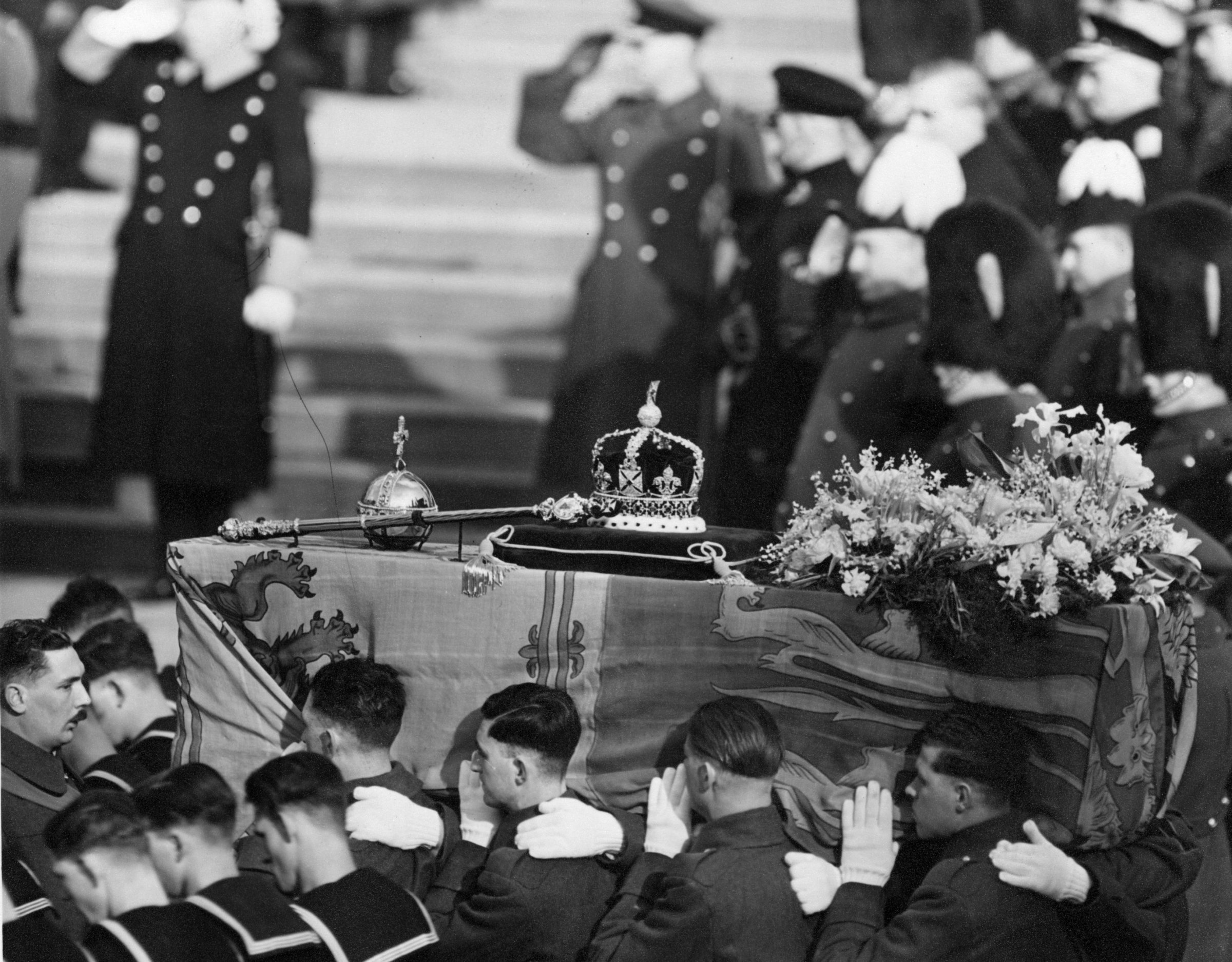
Warning: This post contains spoilers for The Crown
The Crown, Netflix’s new series about the life of Britain’s Queen Elizabeth II, begins on a gruesome note: King George VI (played by Jared Harris) coughing up blood.
Just a few episodes into the big-budget series, which launched on the streaming service last Friday, the King of England is pronounced dead — and his daughter, Elizabeth (Claire Foy), takes the crown. Here’s what you need to know about the real death of His Majesty King George VI:
Who was King George VI?
Albert Frederick Arthur George ruled England for almost 16 years after his brother, Edward VIII, abdicated the throne in 1936 in order to marry Wallis Simpson, a divorced American socialite. (Marriage to a divorcée was forbidden for a king.) He had married Lady Elizabeth Bowes-Lyon in 1923, and the pair had two daughters by the time he took the throne: Elizabeth and Margaret.
The conscientious, dedicated and highly religious King had a stammer, which he never fully overcame—and which was the central topic of the 2010 blockbuster The King’s Speech, which won four Oscars. King George, who called himself a “very ordinary person,” was also the first British monarch to attend a state visit in the United States, which he did in 1939.
What was his health like?
The world first heard of the King’s artery trouble in 1948, when he gave up public appearances because of pain in his right leg and foot. His doctors decided that their patient was a victim of thromboangiitis obliterans, also called Buerger’s disease. They found, too, that all his arteries were hardened beyond his years.
The Second World War took a toll on the King’s health, and it didn’t help that he was a heavy smoker. He developed lung cancer and underwent a serious leg operation for a circulatory ailment, which threatened the loss of his limb. In 1951, he had a lung operation to remove an obstruction in the left bronchus, which he never fully recovered from. “In deciding to risk the operation, the King was guided by advisers of his own choosing,” TIME reported, following the surgery. “In all but their most private affairs, Britain’s constitutional monarchs do what they are told, but the government has no say in their choice of doctors.”
“In his own room, the King was injected with an anesthetic (probably sodium pentothal) by Anesthetist Robert Machray. He was wheeled to the operating room and… his left side propped up slightly with pillows,” the article continued. “After that, Patient George was put on a soft diet, from soft-boiled eggs to such delicacies as steamed fish. Because of his old trouble with poor circulation, it was essential for the King to have a few minutes out of bed each day, as soon as his strength permitted.”
Get your history fix in one place: sign up for the weekly TIME History newsletter
What did that mean for Elizabeth?
King George’s failing health and lung surgery meant delegating more of his royal duties to his daughter Elizabeth, the heir presumptive. On Jan. 31, 1952, he went to London Airport to see her off on a diplomatic visit to Australia and New Zealand, via Kenya, despite medical advice from those close to him.
Elizabeth and her husband Philip spent a night away from the lodge at the Treetops Hotel in Kenya’s Aberdare National Park, where, after seeing the elephants, she was too excited to sleep, as TIME reported, and “kept leaving her cot to watch other nocturnal visitors at the waterhole.” In the morning, “she breakfasted on bacon and eggs, and tossed bananas to baboons below.” It wasn’t until early afternoon that a reporter from a local newspaper called and told Philip that the King had died.
How did he die?
The King was found dead in bed at Sandringham House in Norfolk, on the morning of Feb. 6. He had died from a coronary thrombosis — a blocking of blood flow to the heart as a result of a blood clot in an artery — in his sleep. He was only 56 years old.
“Footman Daniel Long, who took a cup of cocoa to the King at 11 p.m. and found him in bed reading a sportsman’s magazine, was the last person to see the King alive,” TIME’s obituary of the King read. “Early next day, a servant brought the King‘s morning cup of tea. The tea was never drunk: a blood clot had stilled George VI‘s valiant heart as he slept.”
What happened next?
Back in London, “church bells tolled, Union Jacks flew at half-staff, shops and factories closed for the day, and the BBC stopped broadcasting after airing an announcement of the King’s death,” TIME reported. “Crowds of people stood in the cold rain for hours outside Buckingham Palace.”
The King’s coffin rested in St. Mary Magdalene Church in Sandringham, before lying in state at Westminster Hall. His funeral took place at St. George’s Chapel, Windsor Castle, on the 15th. Fifty years later, in 2002, the remains of his wife, Queen Elizabeth the Queen Mother, and the ashes of his daughter Margaret were interred in the chapel alongside him.
More Must-Reads From TIME
- The 100 Most Influential People of 2024
- Coco Gauff Is Playing for Herself Now
- Scenes From Pro-Palestinian Encampments Across U.S. Universities
- 6 Compliments That Land Every Time
- If You're Dating Right Now , You're Brave: Column
- The AI That Could Heal a Divided Internet
- Fallout Is a Brilliant Model for the Future of Video Game Adaptations
- Want Weekly Recs on What to Watch, Read, and More? Sign Up for Worth Your Time
Write to Kate Samuelson at kate.samuelson@time.com